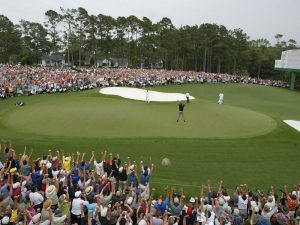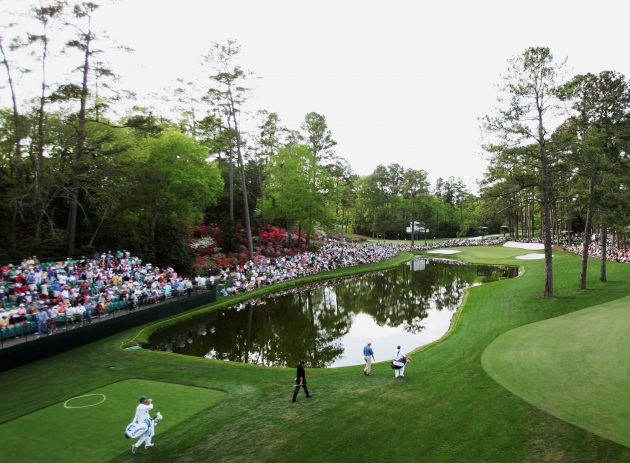Here we take a look at the significance of pin positions on several key holes at Augusta National.

The Significance Of Pin Positions At Augusta
Augusta National, home of The Masters, is one of golf’s most versatile courses. There are few, if any, layouts where the hole difficulty can be affected so dramatically by the choice of pin position.
To a certain extent this is down to changing winds and tees moving up or back, but, more significantly, the difference is because of shifting pin positions.
Below we have taken a look at several holes where the choice of pin location has the most substantial bearing on the challenge the players will have to face.
4th Hole – Flowering Crab Apple
This very long short hole provides a great early-round example of the importance of pin positions at Augusta. When the flag is in the front section of the green, on the narrow portion between the two bunkers, it’s incredibly difficult to get the ball close. There’s only the tiniest margin for error either left or right. If a player does stray laterally, the shot from in (or around) either of those bunkers is devilishly difficult, trying to flip the ball up and stop it on an area of green the size, and speed, of a snooker table.
With the pin in this location in round three last year, it was the hardest hole on the course by some margin. There were six double-bogeys that day – three more than on any other hole. If the pin is at the back, as it was in round one last year, there’s more space to miss on either side and an up-and-down is far more feasible.

The mammoth par-3 4th hole
7th Hole – Pampas
When the pin is at the front of the green, just over the magnetic bunkers, it’s extremely difficult for players to access it. A fraction short means they will end up in the sand, a hair right and the ball drifts to the front right of the green and just long results in an incredibly slippery putt, chip or bunker shot down the slope. From any of those spots, a dropped shot is the likely outcome – and sometimes those straying off line with their approaches head towards the par-5 8th having let two strokes slip.
On Sunday last year, however, the pin was in the lower front-right of the green, with everything feeding towards it. This makes the 7th a huge birdie chance as the margin for error on approaches is widened. To take full advantage, it’s important to find the short grass off the tee. When the pin is front left, it’s take par and move on!
9th Hole – Carolina Cherry
It’s extremely difficult to get close to the flag when it’s way up in the back-left portion of this green. It’s a small target protected by a bunker in front so it’s easy to go long, leaving a treacherous chip back down the slope.
On the final day, the pin is normally positioned towards the front left of the putting surface and anything spinning too much will back up off the green in the style of Greg Norman in 1996. From beyond the flag to the right, players face an incredible putt. You’ll see them starting the ball at right angles to the cup and crossing their fingers that it stays on the green!
Television cameras don’t do the slope justice, but leaving yourself in the right position is imperative. Find sand when the pin is front left and you’re in real trouble, while long and right presents the most treacherous putt at Augusta National.

The elevated 9th hole has several tough pin positions.
11th Hole – White Dogwood
This is the hardest hole on the course when the pin is positioned to the left side of this green, as it tends to be on the first two days. Going at the flag is only for the very bravest as it brings the water into play, so players tend to bail out to the right side.
In the second round last year there were 12 double-bogeys on this hole – five more than the next highest on the course that day. Many came as a result of being too greedy and finding water as a result. It’s not a good idea to bail out right, though, as chips hit with too much conviction have been known to run off the green and into the pond.
In round four, the pin is generally positioned more to the front and right of the green, giving competitors a chance to be a little more aggressive. Look for the best iron players to attack here in round four.

Playing safe is the key at 11 (Getty Images)
13th Hole – Azalea
This hole is one of the easiest on the course by ranking, no matter where the pin is positioned. However, when it’s in the front portion of the green, as it tends to be on the final day, players view it as a must-birdie. The green slopes from back to front and left to right and, when the pin is in the front section, shots fired into the middle of the putting surface will feed down to it. Remember Seve’s second to set up a final-round eagle in 1986?
When the flag is at the back of the putting surface, either on the left or right side, it’s extremely difficult to get the ball close to it. And going long is not clever. From through the green, with the pin at the back, it’s nigh on impossible to get the ball onto the putting surface and stop it before it takes the slope and disappears to the front of the putting surface and into a tributary of Rae’s Creek beyond.

The 13th offers birdie opportunities (Getty Images)
16th Hole – Redbud
The green on this par 3 slopes down hugely from right to left, so when the pin is on the left side (as it always is on the final day – think Tiger Woods’ miracle chip in 2005) the ball will feed towards it. If a player gets the correct distance and doesn’t aim too far right, he’ll have a realistic birdie chance.
When the pin is on the back-right portion, as it was in the first round last year, or the front-right section as in round three, the tee shot must be extremely precise to avoid falling away from the cup and down the slope. Right pins require the player to land the ball within a few feet of the flag on either side to avoid a testing putt.
A small bunker lies in wait to catch any tee shots that come up short, while a number of three-putts stem from players not getting the right pace on approach putts up the tier towards the hole.

16 has offered several iconic Masters moments (Getty Images)
17th Hole – Nandina
This is one of the most challenging greens on the entire golf course and pin positioning makes a massive difference. When the flag is situated on the right side – not only one of the flatter sections of the green but also its low point – anything aimed just to the left of it feeds towards it.
When the pin is positioned just a little further to the left, the proposition is very different – anything missing to the right of the flag feeds away to the low point of the green. Anything long or further left leaves a devilish pitch or long putt down to a pin sitting on a precipice. Just too firm and the ball runs away to the green’s edge, but if you’re too timid you’ll face the same problem with the next shot.
This is one of the elements that makes Augusta such a treacherous golf course – you’d better execute first time around!
US Masters Leaderboard 2019
Who is leading at Augusta?
US Masters Prize Money 2019
The first Major of the year at Augusta…
Masters Weather Forecast 2019
It could be windy this week at Augusta...
18th Hole – Holly
Augusta’s final hole is at its most straightforward when the pin is at the front centre of the green, as the ball will drift back towards it if it lands slightly long. Just think of Sandy Lyle’s impressive bunker shot in 1988.
Conversely, when the pin is towards the back of the green, the challenge is severe and an approach has to be extremely precise to avoid falling away from the cup. When the pin is towards the back of this green, three putts are common. Tom Watson three-putted for a double-bogey six here in 1991 to lose out by two to Ian Woosnam.
Typically, the pin is perched back right, fairly close to the greenside bunker, in round two, while it finds its home in the more hospitable front central location during the final day’s play. A select few, including Lyle and Phil Mickelson in 2004, have birdied the 18th to win The Masters.
Don’t forget to follow Golf Monthly on Facebook, Twitter and Instagram for all the latest news from The Masters.
This article The Significance Of Pin Positions At Augusta appeared first on Golf Monthly.


